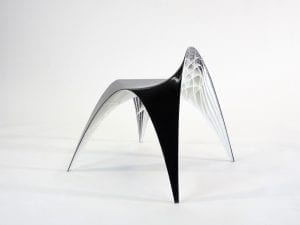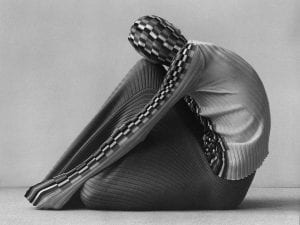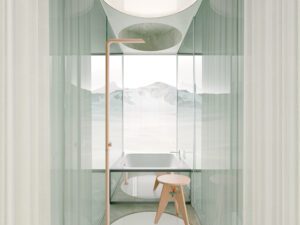Dominika J Rostocka has been professionally active in architecture, interior design and design for 18 years. As both architect and designer, she sees interior design as a passionately creative process, but bases an ethos around functionality.
A: Your business is built upon the influence of Art Deco, why is this movement important to you and why do you think that it resonates today
DR: I’m a fan of classical forms. I adore geometry and clever solutions. I’ve been fascinatedby Art Deco for as long as I can remember. It’s significant to me, so I take all its manifestations – both the historical ones and the modern interpretations – very personally. I’m an architect by education, but I also completed postgraduate course on historic buildings conservation. Thanks to that, I had the pleasure of working on classical objects right at the beginning of my career. Then, the interior design came along. And for a while now, I’ve also been developing rapidly in the fields of design and strictly artistic activity. I’ve subconsciously felt that in each of these fields, especially in their luxurious areas, looking for inspiration in the inter-war period was a right way to find timeless elegance and class. Today, Art Deco aesthetics got back in everyone’s good graces. It makes me extraordinarily happy – I believe that with my education and design activism, I helped to rediscover that style at least on Polish market.
A: With over 640 completed designs made internationally, what is the vision that you’re wanting to share with the world?
DR: Above all else, I’d like to emphasise that the world is continuously changing, that it flows forward. The job of an interior designer should be reserved only for the real enthusiasts, who are able to notice the differences and appropriately address them in their own works. When it comes to me, I visited all major exhibitions, trade fairs and art fairs both in Europe and worldwide to notice those differences. I spent a lot of time and energy on this – my passion is observing the modern influences of specific countries, movements, and manufactures, on the design in general. I also see how it influences us as interior designers. It was thanks to the experience I gained while creating and realising these 640 interior design projects that I can boast about conscious, or even calculated approach to each of them, about refinement of each decorative and utilitarian element of the interior. I endlessly come up with new materials. I try to be innovative, but at the same time I revive historical decorative techniques. A striking mix of these two worlds is my professional vision.
A: How do you think that the spaces people inhabit affect their daily lives, and how do you respond to that within your interior and exterior practice?
DR: The job of an interior designer requires, besides knowledge and education, also numerous soft skills, including knowledge of certain aspects of psychology and observational skills. Looking at personal styles and lifestyles of people, I see eternally moving kaleidoscope that greatly inspires me. I try to adjust the interior to the client, to their rituals and habits, to achieve a project that sympathises with them, supports and completes their lifestyle. Most often, my work takes me also into the architecture field. It’s a perfect solution – I carry out the process with psychological elements starting from the exterior, then proceeding into the interior, harmonising and combining them. I truly believe that these two parts both have a great influence on its inhabitants, so they should be as consistent as possible – the interior must coexist with and correspond to the architecture.
A: How do you think that the two practices relate – how do you create dialogues between the two and what interests you about being involved in both construction and furnishing?
DR: Besides the relationship between the interior and the exterior and designing them as whole that I’ve already mentioned, scrupulous tailor-made design of a house or an interior brings financial gains. I can plan the investment in a way that, with properly planned budget, gives my client the best possible solution not only due to my experience as a designer, but also thanks to available to me material and realisation solutions. An investment like that is designed for a specific client, start to finish, it suits their wants and goals which we find and then achieve together.
A: Your success has spread to Poland, Spain, Italy and Germany. What is it about these European countries in particular that find a passion in reviving Art Deco?
DR: Thanks to the cultural diversity, in each of these countries there is something else that inspires me. For example in Spain, I can realise designs of simple, modern interiors. In Germany, I focus on modernism and minimalism. Simultanously, in Poland I answer to the clients’ interest in “New Classic”, which is the most fashionable style at the moment.
However, I meet with enthusiasm for Art Deco and its modern interpretation everywhere I go. These demanding, prosperous clients that I work with are exceptionally sensitive to the quality of even the smallest details in every country. They expect uniqueness, timeless elegance, and materials of the highest quality. References to Art Deco meet these expectations. Moreover, I can proudly say, that regardless of the vision of the client I have the pleasure of working with and their chosen aesthetics, the continuous flow of commissions to my design studio is ensured by my, already known on the market, complete attention to each detail and its place in the project.
A: Your work was recently exhibited at 100% Design London as the first collection of furniture and interior design objects. How did this event manoeuvre within your practice as an important trade event?
DR: The event motivated me to polish my current collections and ensure their quality so they could truly shine on the international market. The significance of the event matched my vision of the New Art Deco Collection premiere. I wanted to use the time of this event to close this endlessly growing collection even for a moment and inform the world of its existence. I regard the London debut as exceptionally successful. The enthusiastic feedback of international audience was overwhelming. It also motivated me to create new projects, which will be revealed soon.
A: What have you got planned in terms of future projects / exhibitions?
DR: Participation in an event like 100% Design in a role different than a guest was an immense pleasure and it convinced me to plan next exhibitions. As of today, I’d like to present my passion for design and art to the biggest audience possible. It’s with these subjects that I wish to participate in international trade events as an exhibitor again, most probably soon. The only challenge in preparation for this kind of event is time. My interior design studio is currently in overdrive, and my priority is satisfaction of the clients I’ve already have. As soon as the projects are finished, I’ll organise photography sessions with them and happily share them with you!
For more information: www.rostocka.com
Credits:
1. Courtesy of Rostocka.




